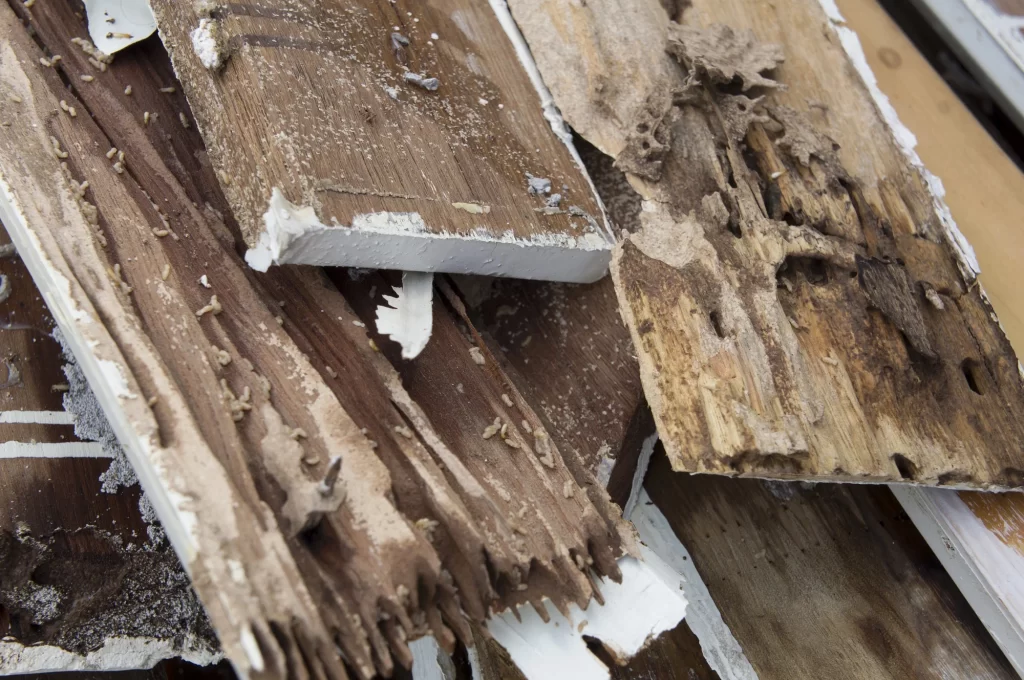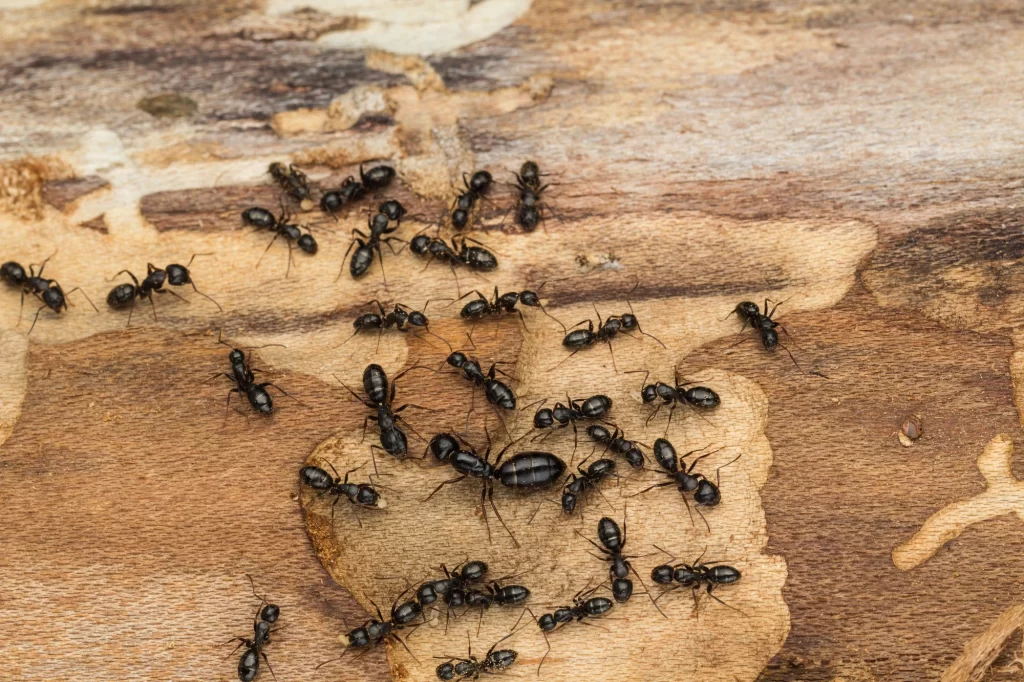Carpenter Ant Frass: Understanding Infestation, Identification, and Control Termite frass

When you discover sawdust-like material around your home, it could be a sign of a carpenter ant infestation. These ants don’t consume wood like termites, but they excavate it to build their nests, leaving behind what is known as frass. Carpenter ant frass is typically a mix of wood shavings, insect body parts, and other debris, distinguishing it from termite frass, which looks like tiny pellets. Understanding the differences between these pests is crucial for effective pest control. This article dives into everything you need to know about carpenter ant frass, identifying signs of an infestation, and controlling these destructive insects.
What Are Carpenter Ants?
Carpenter ants are a common pest that is often found in homes, particularly in areas with moist or decaying wood. Unlike termites, carpenter ants do not eat wood. Instead, they excavate it to create galleries for their nest. The resulting frass consists of fine wood shavings, pieces of insects, and sometimes fecal pellets. These ants can cause structural damage to homes if left unchecked.
Understanding Carpenter Ant Frass
Carpenter ant frass is an important indicator of an infestation. The frass resembles sawdust or wood shavings and is typically found near entry points like window frames, door frames, or wall voids. Unlike termite frass, which appears as small, pellet-like droppings, carpenter ant frass doesn’t contain insect parts. This distinction can help homeowners identify the type of infestation they are dealing with.

What Does Carpenter Ant Frass Look Like?
To identify carpenter ant frass, look for a coarse material that is similar in appearance to wood shavings or sawdust. The frass left behind by these ants is sometimes mixed with insect body parts and debris, and can often be found around your home near the carpenter ant nests. Unlike termite frass, which is granular, carpenter ant frass tends to look more like shavings. Understanding what this frass looks like can help in taking immediate action against a potential infestation.
Carpenter Ant Frass vs. Termite Frass: How to Tell the Difference?
Comparison Table: Carpenter Ants vs. Termites
| Feature | Carpenter Ants | Termites |
|---|---|---|
| Primary Diet | Do not eat wood, excavate to nest | Eat wood, causing structural damage |
| Frass Appearance | Wood shavings, insect parts | Pellet-like droppings (termite frass) |
| Nest Location | Moisture-damaged wood, wall voids | Inside wooden structures, soil, trees |
| Damage Type | Creates galleries inside wood | Consumes wood, hollowing structures |
| Control Methods | Baits, insecticides, sealing entry points | Termiticide barriers, fumigation |
| Activity Time | Nocturnal | Active day and night |
Termites and carpenter ants are two common pests that can cause structural damage to your home. However, their frass is different. Termite frass appears as small pellets, often found near damaged wood. Carpenter ant frass, on the other hand, includes wood shavings and insect body parts. Knowing the difference between termite and carpenter ant frass is crucial for determining the appropriate pest control measures.
Signs of Carpenter Ant Infestation: What to Look For?
If you suspect a carpenter ant infestation, look for signs like carpenter ant frass, visible ant trails, or the presence of winged ants. Carpenter ants are usually more active at night, and worker ants often leave the nest to forage for food, creating noticeable paths. Additionally, you may notice a rustling sound from within walls, which is caused by the ants excavating wood to expand their galleries.
How to Identify Carpenter Ant Nests?
Carpenter ant nests are often found in areas with moisture-damaged wood such as window and door frames, attics, and even tree limbs. These nests can be challenging to locate because carpenter ants tend to build their nests in secluded areas like wall voids or behind insulation. Understanding where these ants prefer to nest can help in locating and treating the infestation.
Carpenter Ant Problems: Risks of Structural Damage
A carpenter ant infestation can lead to significant structural damage to your home if not addressed promptly. These ants excavate wood to build their galleries, potentially compromising the integrity of your home’s framework. Unlike termites, which eat wood, carpenter ants don’t consume wood but still cause substantial harm by hollowing it out. Over time, these tunnels weaken the structure, making it vulnerable to further damage.
Effective Carpenter Ant Control Methods
To address a carpenter ant infestation, various pest control strategies can be employed. Options include using baits, applying insecticides directly to the nest, and sealing potential entry points around your home. However, controlling a carpenter ant colony can be challenging due to their nocturnal nature and the hidden locations of their nests. It is often advisable to consult a pest control professional for effective and long-lasting results.
Comparison Table: Carpenter Ant Control Methods
| Control Method | Effectiveness | Pros | Cons | Best Used When |
|---|---|---|---|---|
| Baiting | Moderate | Effective for large infestations, easy to use | Slow acting, ants must forage for bait | Multiple nests, widespread colonies |
| Direct Insecticide Application | High | Immediate results, targets specific nests | May require professional application | Identified nests, localized infestation |
| Preventive Measures | Moderate | Low cost, prevents future infestations | Requires ongoing maintenance | High-risk areas, recurrent ant problems |
| Sealing Entry Points | High | Blocks ants from entering homes, low cost | Does not eliminate existing ants | After infestation has been treated |
| Professional Pest Control | Very High | Expert assessment, tailored solutions | More expensive than DIY | Severe infestations, structural damage risk |
Preventing Carpenter Ant Infestations in Your Home
Preventing a carpenter ant infestation involves eliminating sources of moisture and decaying wood around your property. Regularly inspect and repair damaged wood structures such as door frames, window frames, and tree limbs. Additionally, seal any cracks or crevices in your home’s exterior to prevent carpenter ants from gaining entry. Proper home maintenance can significantly reduce the risk of an infestation.
When to Call a Pest Control Professional?
If you’ve found carpenter ant frass or other signs of an infestation, it may be time to call a pest control company. Professionals can accurately identify the type of pest, locate the nest, and apply targeted treatments. A pest control professional can also provide preventative measures to keep your home safe from future infestations. Contact us today to get a free inspection and discuss the best course of action to protect your home from these destructive insects.
If you need help identifying or dealing with a carpenter ant infestation, don’t hesitate to contact a pest control company. They can provide a tailored solution that fits your needs, ensuring your home remains safe and pest-free.
Conclusion
Carpenter ants and termites are often confused due to their similar habits, but understanding the differences is crucial for effective pest management. Carpenter ants may leave behind ant frass, which looks like wood shavings, unlike termite droppings that do not contain insect parts. While black carpenter ants are one common species of carpenter ants, they, like others, prefer damp wood to establish their nests. Notably, carpenter ants are nocturnal, and their frass can help identify an infestation.
If you notice ant activity, like ant crawling or debris and frass, especially inside your home, it could signal a parent colony or new colonies nearby. Both carpenter ants and termites can cause significant damage, but carpenter ants don’t eat wood; they excavate to build their galleries, unlike drywood termites. Look for ant droppings, also called carpenter ant frass, which is usually pushed out of their nests.
For any signs of a carpenter ant infestation, or if you want to learn more about pest management, don’t hesitate to reach out to our expert team. Visit our Gallery to see how we can help protect your home, or contact us at (773) 679-7833 or info@prairielandgarages.com for personalized advice and solutions. We are here to help you prevent these insects like carpenter ants and other pests from becoming a serious issue.
